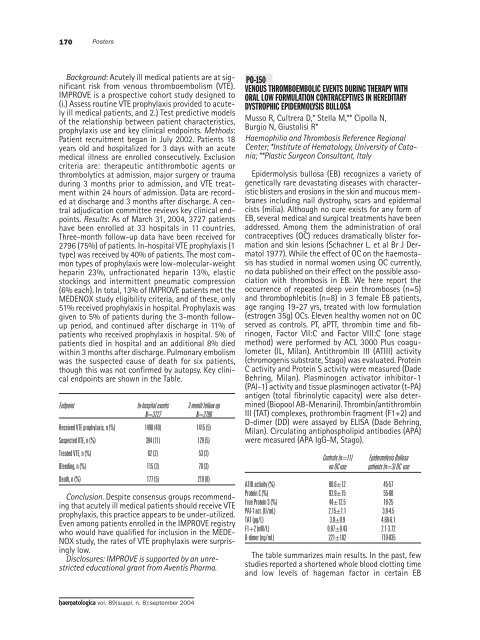Haematologica 2004;89: supplement no. 8 - Supplements ...
Haematologica 2004;89: supplement no. 8 - Supplements ...
Haematologica 2004;89: supplement no. 8 - Supplements ...
- No tags were found...
You also want an ePaper? Increase the reach of your titles
YUMPU automatically turns print PDFs into web optimized ePapers that Google loves.
170PostersBackground: Acutely ill medical patients are at significantrisk from ve<strong>no</strong>us thromboembolism (VTE).IMPROVE is a prospective cohort study designed to(i.) Assess routine VTE prophylaxis provided to acutelyill medical patients, and 2.) Test predictive modelsof the relationship between patient characteristics,prophylaxis use and key clinical endpoints. Methods:Patient recruitment began in July 2002. Patients 18years old and hospitalized for 3 days with an acutemedical illness are enrolled consecutively. Exclusioncriteria are: therapeutic antithrombotic agents orthrombolytics at admission, major surgery or traumaduring 3 months prior to admission, and VTE treatmentwithin 24 hours of admission. Data are recordedat discharge and 3 months after discharge. A centraladjudication committee reviews key clinical endpoints.Results: As of March 31, <strong>2004</strong>, 3727 patientshave been enrolled at 33 hospitals in 11 countries.Three-month follow-up data have been received for2796 (75%) of patients. In-hospital VTE prophylaxis (1type) was received by 40% of patients. The most commontypes of prophylaxis were low-molecular-weightheparin 23%, unfractionated heparin 13%, elasticstockings and intermittent pneumatic compression(6% each). In total, 13% of IMPROVE patients met theMEDENOX study eligibility criteria, and of these, only51% received prophylaxis in hospital. Prophylaxis wasgiven to 5% of patients during the 3-month followupperiod, and continued after discharge in 11% ofpatients who received prophylaxis in hospital. 5% ofpatients died in hospital and an additional 8% diedwithin 3 months after discharge. Pulmonary embolismwas the suspected cause of death for six patients,though this was <strong>no</strong>t confirmed by autopsy. Key clinicalendpoints are shown in the Table.Endpoint In-hospital events 3-month follow-upN=3727 N=2796Received VTE prophylaxis, n (%) 1490 (40) 1415 (5)Suspected VTE, n (%) 394 (11) 129 (5)Treated VTE, n (%) 62 (2) 53 (2)Bleeding, n (%) 115 (3) 70 (3)Death, n (%) 177 (5) 219 (8)Conclusion. Despite consensus groups recommendingthat acutely ill medical patients should receive VTEprophylaxis, this practice appears to be under-utilized.Even among patients enrolled in the IMPROVE registrywho would have qualified for inclusion in the MEDE-NOX study, the rates of VTE prophylaxis were surprisinglylow.Disclosures: IMPROVE is supported by an unrestrictededucational grant from Aventis Pharma.PO-150VENOUS THROMBOEMBOLIC EVENTS DURING THERAPY WITHORAL LOW FORMULATION CONTRACEPTIVES IN HEREDITARYDYSTROPHIC EPIDERMOLYSIS BULLOSAMusso R, Cultrera D,* Stella M,** Cipolla N,Burgio N, Giustolisi R*Haemophilia and Thrombosis Reference RegionalCenter; *Institute of Hematology, University of Catania;**Plastic Surgeon Consultant, ItalyEpidermolysis bullosa (EB) recognizes a variety ofgenetically rare devastating diseases with characteristicblisters and erosions in the skin and mucous membranesincluding nail dystrophy, scars and epidermalcists (milia). Although <strong>no</strong> cure exists for any form ofEB, several medical and surgical treatments have beenaddressed. Among them the administration of oralcontraceptives (OC) reduces dramatically blister formationand skin lesions (Schachner L. et al Br J Dermatol1977). While the effect of OC on the haemostasishas studied in <strong>no</strong>rmal women using OC currently,<strong>no</strong> data published on their effect on the possible associationwith thrombosis in EB. We here report theoccurrence of repeated deep vein thromboses (n=5)and thrombophlebitis (n=8) in 3 female EB patients,age ranging 19-27 yrs, treated with low formulation(estrogen 35g) OCs. Eleven healthy women <strong>no</strong>t on OCserved as controls. PT, aPTT, thrombin time and fibri<strong>no</strong>gen,Factor VII:C and Factor VIII:C (one stagemethod) were performed by ACL 3000 Plus coagulometer(IL, Milan). Antithrombin III (ATIII) activity(chromogenis substrate, Stago) was evaluated. ProteinC activity and Protein S activity were measured (DadeBehring, Milan). Plasmi<strong>no</strong>gen activator inhibitor-1(PAI-1) activity and tissue plasmi<strong>no</strong>gen activator (t-PA)antigen (total fibri<strong>no</strong>lytic capacity) were also determined(Biopool AB-Menarini). Thrombin/antithrombinIII (TAT) complexes, prothrombin fragment (F1+2) andD-dimer (DD) were assayed by ELISA (Dade Behring,Milan). Circulating antiphospholipid antibodies (APA)were measured (APA IgG-M, Stago).Controls (n=11)<strong>no</strong> OC useEpidermolysis Bullosapatients (n=3) OC useATIII activity (%) 88.6±12 45-57Protein C (%) 92.9±15 55-68Free Protein S (%) 44±12.5 18-25PAI-1 act. (U/mL) 2.15±1.1 3.8-4.5TAT (µg/L) 3.0±0.9 4.68-6.1F1+2 (nM/L) 0.87±0.43 2.1-3.72D-dimer (ng/mL) 221±102 710-835The table summarizes main results. In the past, fewstudies reported a shortened whole blood clotting timeand low levels of hageman factor in certain EBhaematologica vol. <strong>89</strong>(suppl. n. 8):september <strong>2004</strong>
















